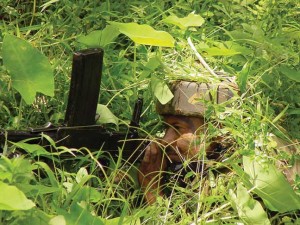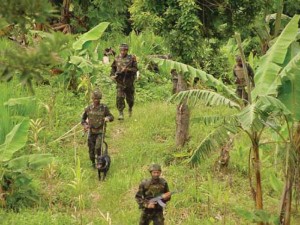The traditional concept of national security has undergone significant fundamental changes. It is no longer synonymous with military strength but includes internal cohesion, economic strength and technological prowess7. This is compounded by the changing nature of modern warfare. William S Lind has identified four different generations of wars. The first generation related to concentrating manpower with the help of line and coloumn tactics, the second to concentrating firepower with the help of artillery, the third to manoeuvre tactics and employing airpower and the fourth generation to asymmetric wars focussing on collapsing the enemy internally8. Presently, our organisational structures are focussed towards fighting third generation wars.
 The intertwining of world economies is making traditional conflict more distant and a terror war more relevant. There is therefore a need to re-structure our armed forces to tackle more efficiently the asymmetric threat that is omnipresent today. In India, this type of warfare is personified by the mushrooming of pan Islamist militant outfits that find direct or indirect links with radical organisations, development of Naxalite and left wing instabilities and proliferation of armed violence9 led by criminal elements enjoying political patronage. The different examples include Delhi bombings in Oct 2005, killing of innocents by Naxalites in Feb 2006 and Varanasi attacks in Mar 2006. These asymmetric threats need a different force structure and an integrated response that links paramilitary elements, police forces and other arms of political power with the armed forces.
The intertwining of world economies is making traditional conflict more distant and a terror war more relevant. There is therefore a need to re-structure our armed forces to tackle more efficiently the asymmetric threat that is omnipresent today. In India, this type of warfare is personified by the mushrooming of pan Islamist militant outfits that find direct or indirect links with radical organisations, development of Naxalite and left wing instabilities and proliferation of armed violence9 led by criminal elements enjoying political patronage. The different examples include Delhi bombings in Oct 2005, killing of innocents by Naxalites in Feb 2006 and Varanasi attacks in Mar 2006. These asymmetric threats need a different force structure and an integrated response that links paramilitary elements, police forces and other arms of political power with the armed forces.
The IDS presently is oriented more towards preparing Long Term Perspective Plans (LTPP), budgeting plans, net assessments and joint doctrines. Even LTPP is mostly an overlay of individual service specific requirements rather than being based on a jointly appreciated need for an optimised force structure to tackle emerging threats or to take into account the aspirations of India becoming a regional power in the near future. There is an urgent need to identify a long term force structure development strategy to ensure that the armed forces are geared towards tackling threats that range from asymmetric to NBC.
India’s rapid economic growth has made the world take notice of our emerging capabilities. This is reflected in the recently concluded nuclear deal with the US. Air Chief Marshal SP Tyagi has highlighted that “the area of interest for us today extends from the Eastern coast of Africa in the West, Sumatra to the East and the entire Indian Ocean to the South. The Indian armed forces now need to re-organise, re-equip and train themselves for contingencies stretching much beyond our frontiers”10.
At the core of being a regional power, rests the condition of acceptance by the international community of priority rights and responsibilities of intervening within the region. Intervention would then be a ‘right’ as well as a solemn responsibility11. India’s growing economic and military might would require our armed forces to be increasingly employed in Out of Area Contingencies (OOAC). There is thus a need to institutionalise those structures that prepare us to undertake our rightful future responsibilities. The lack of CDS and a unified operational structure stands out sorely in performing this vital function.
Levels of Warfare
The strategic level of warfighting constitutes the political strategic level and the military strategic level. The political strategic level is where national security strategy is formulated and it includes NSC, CCS, SPG, NSAB and NSCS. On the other hand, the military strategic level formulates the military strategy and acts as an interface between the political, diplomatic and economic arms on one hand and the three services on the other. The other levels are the operational and tactical levels related to the employment of various arms and services to achieve strategic objectives.
Present Structure of Operational Commands
The Indian Army is divided into six operational commands, the Northern Command (NC) at Udhampur, Western Command (WC) at Chandimandir, South Western Command (SWC) at Jaipur, Eastern Command (EC) at Kolkata, Southern Command (SC) at Pune and Central Command at Lucknow. On the other hand, IAF currently has five operational commands, namely Western Air Command (WAC) at Delhi, South Western Air Command (SWAC) at Gandhinagar, Southern Air Command (SAC) at Trivandrum, Central Air Command (CAC) at Allahbad and Eastern Air Command (EAC) at Shillong.
The Indian Navy is deployed under three area commands; Western Naval Command (WNC) at Mumbai, Southern Naval Command (SNC) at Kochi and the Eastern Naval Command (ENC) at Vishakhapatnam12. The operational commands of the three services are not co-located. Further, the area of responsibility (AOR) covered by Western Air Command equates to the combined AOR’s of NC, WC and SWC of the Indian Army.
Theatre of Operations : Case Study of US and Australia
US Commands. The term theatre of operations is defined in the American field manuals as land and sea masses to be invaded or defended including areas necessary for administrative activities incident to the military operations. In the western concept, the European Theatre of Operations was used to refer to all military activity in Europe whilst Pacific Theatre of Operations was related to the Pacific Ocean13. Hence, the inherent meaning of Theatre of Operations relates to large contiguous land or sea areas where synergised operations take place.
 A Unified Command is a command with a broad continuing mission. It operates under a single commander and is composed of two or more services14. The US Regional Combatant Commands have geographical areas of responsibility. They conduct the strategic direction of all US military operations within their designated AOR. The five regional unified commands are US Atlantic Command, Central Command, European Command, Pacific Command and Southern Command. In addition, they have functional commands such as US Space Command, Special Operations Command, and the Strategic Command. For Special Operations, a Joint Special Operations Task Force (JSOTF) is formed to plan, rehearse and execute operations regardless of their geographical location. In 1986, the US Govt brought the Goldwater Nichols amendment to ensure complete jointness despite Joint Chiefs of Staff being in place since 1947.
A Unified Command is a command with a broad continuing mission. It operates under a single commander and is composed of two or more services14. The US Regional Combatant Commands have geographical areas of responsibility. They conduct the strategic direction of all US military operations within their designated AOR. The five regional unified commands are US Atlantic Command, Central Command, European Command, Pacific Command and Southern Command. In addition, they have functional commands such as US Space Command, Special Operations Command, and the Strategic Command. For Special Operations, a Joint Special Operations Task Force (JSOTF) is formed to plan, rehearse and execute operations regardless of their geographical location. In 1986, the US Govt brought the Goldwater Nichols amendment to ensure complete jointness despite Joint Chiefs of Staff being in place since 1947.




